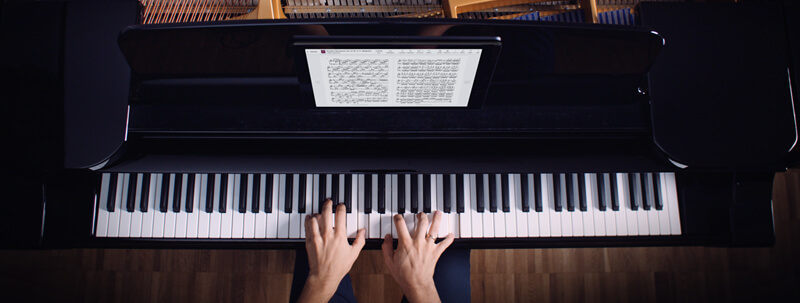How to Play the A-Major Scale on the Piano - Scales, Chords & Exercises
4 minute read
Learn everything about the A-Major scale for piano - notes and fingerings for both hands included! Exercise the A-Major scale and chords to improve your playing skills and music theory knowledge.
A-Major is frequently used in compositions for string music. Some composers have claimed it "is the fullest sounding key for the violin". A famous example in A-Major is Franz Schubert's "Trout Quintet". A-Major is also frequently used in Pop music as it is easy to play on the guitar. As a piano player, you will need to be able to understand and use A-Major in any genre you want to explore. Despite its three sharps - C-sharp, F-sharp, and G-sharp - it is not hard to learn at all.
✨ Unlock Your Piano Power!
Subscribe to 'All Things Piano' by OKTAV.
You get a fascinating chord poster + exclusive content!
Success! Please check your inbox.

What are the Notes of the A-Major Scale?
The A-Major scale starts on A and includes three sharp notes. It uses the notes A-B-C#-D-E-F#-G#-A. On the piano, you need to play three black keys: C#, F#, and G#.
How to Play A-Major With the Right Hand (Treble Clef)
On the piano, you can play the A-Major scale going up (toward the higher notes), or coming down.
- Play the following notes going up: A-B-C#-D-E-F#-G#-A. Start playing with your first finger, and tuck your thumb after you have played the third note, the C#, to reach the D. As you continue playing, you will reach the higher A with your fifth finger.
- Play the following notes going down: A-G#-F#-E-D-C#-B-A. Start playing with your fifth finger on the A and play the full hand down to D, then tuck your third finger over the thumb to play the C#, and continue until your first finger reaches the A.
How to Play A-Major With the Left Hand (Bass Clef)
Piano beginners may find it difficult to read and play the left hand. It is worth investing some time to really familiarize yourself with the notes of the A-Major scale in the bass clef, and learn how to read them in music scores.
The notes are the same as in the right hand (A-B-C#-D-E-F#-G#-A), but they look different in the different clefs:
How to Play:
- Going up: Starting with your fifth finger (the pinkie) on A, play the full hand. Then, when you've reached the E, tuck your third finger over the thumb to reach the F#. Then continue up to the A, played with your first finger.
- Coming down: Start with your first finger. After three notes, tuck your thumb under to reach the E, then play the full hand back down to A.
The A-Major Key Signature
The key signature, located at the beginning of each line of a piece, lets you see which notes will be raised (#) or lowered (b) consistently throughout that piece. If you spot a key signature looking like this, it is very likely that the piece is in A-Major (or its parallel minor key, F-sharp minor, you can determine that from the "mood" of the piece):
6 Exercises to Practice the A-Major Scale
Play one A-Major exercise after the other and only move on after having correctly played the previous exercise 5 times on your piano:
- Play the left hand up and down using a metronome and slowly increasing speed
- Play the right hand up and down using a metronome and slowly increasing speed
- Play both hands up and down using a metronome and slowly increasing speed
- Play the left hand up starting from the lowest A to the highest, and down starting from the highest A to the lowest
- Play the right hand up starting from the lowest A to the highest, and down starting from the highest A to the lowest
- Play both hands up starting with the left hand on the lowest A and stopping when the right hand reaches the highest A, then play down to the starting position.
Why you should exercise scales in general
- To memorize a scale
- To practice dexterity and intonation (play all keys with even loudness. Beginners often play the notes they work with their stronger fingers much harder. Aim for an even tone)
- To be able to play the scale in time without hesitating to find your fingerings
- To be able to build chords and improvise
The A-Major Chord
A-major chord is constructed of three or more notes: The root note - the major third - the perfect fifth.
In short, this tells us about A-Major:
- The basic A-Major chord consists of A-C#-E.
- The first inversion is C#-E-A.
- The second inversion is E-A-C#.
To practice the A-Major chord and its inversions, switch from the chord starting with the root note to the first, and the second inversion, starting slowly using a metronome, then increase your tempo.
Popular Pieces in A-Major










